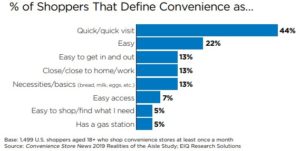How Do Consumers Define Convenience?

Merriam-Webster defines “convenience” as something that is “designed for quick and easy preparation or use”. Traditionally, for business owners, location has created convenience. The soul of convenience stores is built on their ability to serve people and communities closest to them. Rarely will you find a convenience store plopped in the middle of a commercial city center or downtown area. Gas stations, small markets, or mom & pop shops are almost always within walking distance of a neighborhood. But how do convenience store shoppers living in nearby neighborhoods define “convenience”?
There’s more to it than just location. Shoppers have favorite drinks & snacks, they look for the lowest prices, appreciate when a store has new flavors and products regularly, and have clean restrooms. Each of those things is just one part of the total experience a shopper has when they visit a convenience store. To each individual, one may be more important than another when deciding which c-store to stop at.
According to Convenience Store News, when asked what shoppers define convenience as, only 13% of those surveyed stated location. The remaining shoppers cited other aspects of their experiences, with quick visits leading the poll.

Ultimately, the majority of shoppers want their convenience store experience to be “easy”. They want to find their items quickly, in clearly labeled aisles. They should be able to purchase food and drink basics like milk, bread and eggs on a moment’s notice. All shoppers want to be able to enter the store with ease, regardless of any mobile restrictions they have such as wheelchairs, canes, or scooters.
Stopping at the local-corner store has become more than just habit. Our reliance on vehicles and travel make convenience stores a necessity. Successful c-store owners know this and will create an atmosphere where shoppers feel comfortable and at ease, hopefully even slowing down a bit to check out new products or indulge themselves.
Convenience store owners that cater to their shoppers’ experience also understand a shift is happening in spending. The Realities of the Aisle Study, confirm that the shift is generational. Younger shoppers, Millennials and Gen. X’ers, spent more than older shoppers. Younger generations are moving quicker, and plan ahead less than their elders. Unplanned meals and snacks creates more frequent stops at convenience stores and higher spending.
How can your store keep up with the change of definition and experience? Your primary task will be to fully understand and track operations. Mobile brand standards software like Action Card allows you to plan your work, collaborate with your employee chain, and drive consistency. Our client, Bucky’s Convenience Stores has implemented our software to help form a plan of action around store operations.
If you’re interested in learning more about how the Action Card app can help your convenience store create exceptional shopper experiences, sign up for a free demo today!
